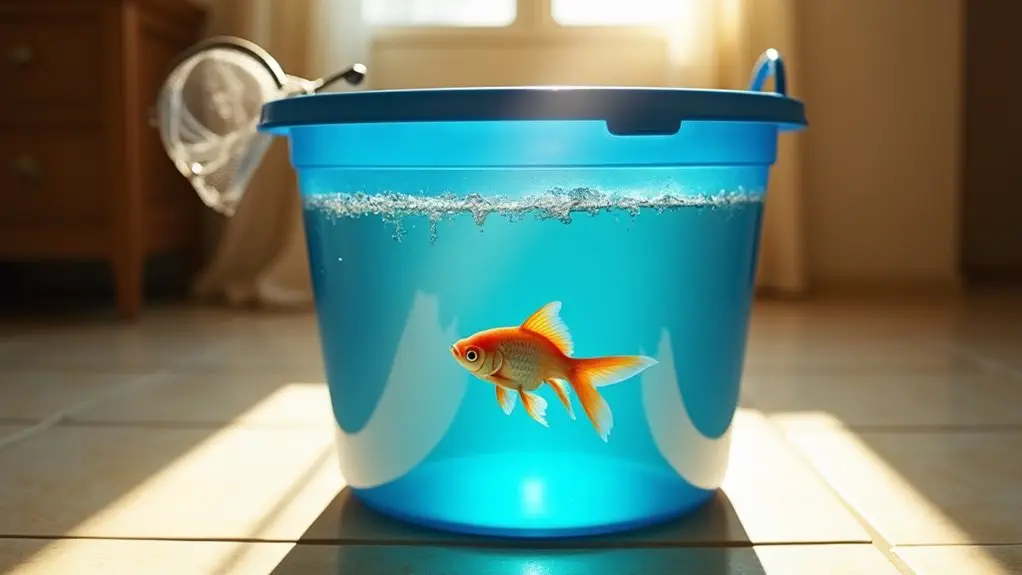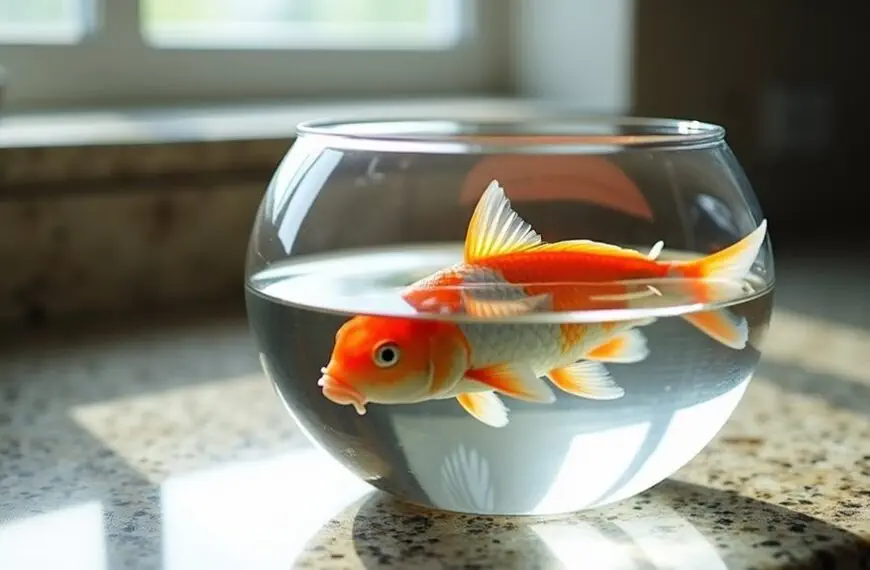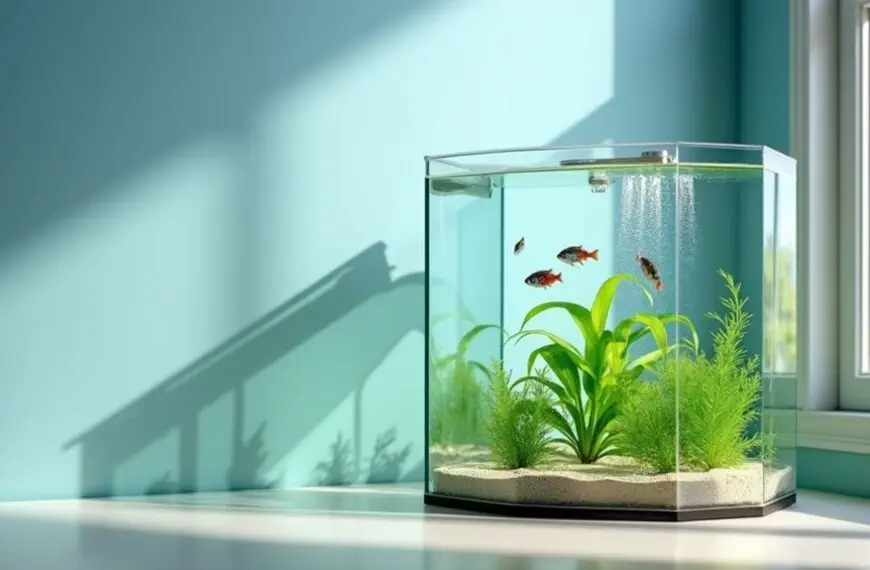Yes, you can safely put your fish in a bucket while cleaning their tank, but you'll need to follow some important guidelines. Use a clean, never-used 5-gallon bucket filled with existing tank water to keep your fish comfortable and stress-free. Make sure the water temperature matches their tank exactly, as even small temperature changes can harm them. Don't keep them in the bucket for more than 30 minutes, and consider adding an air stone for oxygen. Watch for signs of stress like rapid breathing or unusual swimming patterns. There's quite a bit more to keeping your finned friends safe during tank maintenance.
Contents
- 1 Why Use a Bucket
- 2 Preparing Your Bucket Properly
- 3 Safe Fish Transfer Methods
- 4 Water Temperature and Quality
- 5 Time Limits for Bucket Storage
- 6 Signs of Fish Stress
- 7 Bucket Size Requirements
- 8 Multiple Fish Management
- 9 Equipment and Tools Needed
- 10 Returning Fish to Tank
- 11 Frequently Asked Questions
- 11.1 What Happens if My Fish Gives Birth While in the Bucket?
- 11.2 Can I Use the Same Bucket for Different Species of Fish?
- 11.3 Should I Feed My Fish While They're in the Bucket?
- 11.4 Will My Fish Remember Their Territory When Returned to the Tank?
- 11.5 Can Medications Be Added to the Bucket Water During Tank Cleaning?
- 12 Final Thoughts
Why Use a Bucket
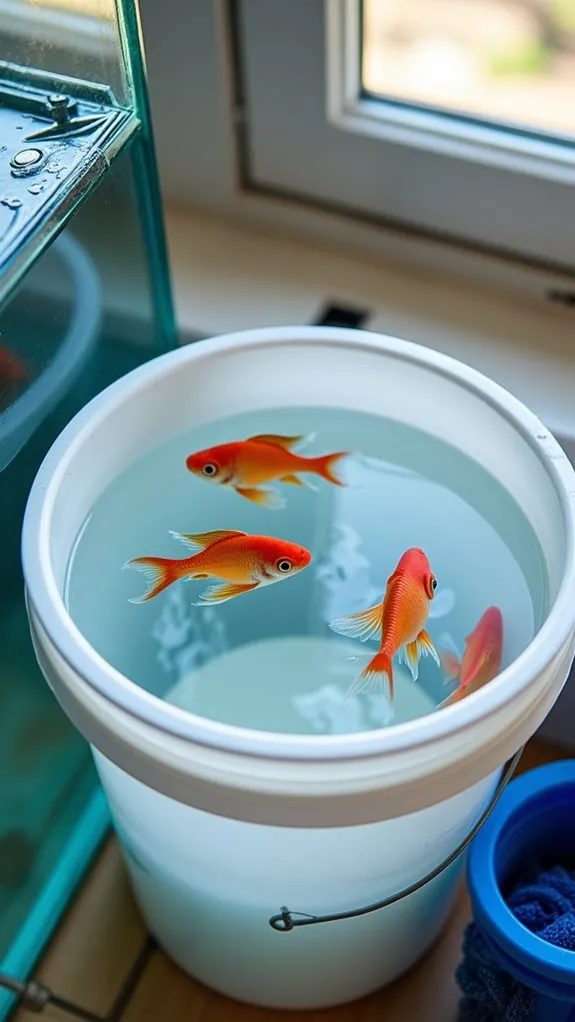
A bucket serves as an essential tool for fish transportation and temporary housing, offering several advantages over traditional methods. When you're dealing with fish behavior, you'll find that buckets provide a more stable environment that helps minimize stress and anxiety in your aquatic friends. Make sure to maintain the water temperature between 78℉ and 82℉ for optimal fish health.
Unlike plastic bags that can bounce and splash around, buckets offer a steadier ride that'll keep your fish calmer during transport. You'll notice a significant difference in stress reduction when using a bucket, as it gives your fish more room to move naturally while maintaining better oxygen levels. Using multiple buckets allows you to achieve better oxygenation levels compared to traditional bags.
Think of it as giving your fish a first-class ride instead of cramming them into economy! The simplified handling also means you're less likely to accidentally startle your fish, and they'll appreciate the extra space to swim around.
A bucket's versatility makes it perfect for various situations, whether you're moving fish to a new tank or performing routine maintenance. You can easily set up multiple buckets if you need to separate different species, and with proper equipment like an air stone, you're creating a comfortable temporary home for your finned pals.
Preparing Your Bucket Properly
You'll need a bucket that's large enough for your fish to move comfortably, and it's essential to use one that's never held cleaning products or chemicals. Additionally, ensure the bucket has been rinsed thoroughly to prevent any harmful toxic buildup that could stress your fish.
Make sure the water temperature in your bucket matches your tank's temperature exactly, or you'll risk shocking your fish during the transfer.
Before you begin moving your fish, give the bucket a thorough rinse with plain water to remove any dust or debris that could harm your aquatic friends. It's best to limit your fish's time in the temporary bucket to under 30 minutes to minimize stress. Remember to test water parameters before transferring fish to ensure the bucket water is safe and compatible.
Bucket Size and Type
When it comes to choosing the right bucket for your fish, size and material are essential factors that can impact their safety during transport. For ideal bucket capacity, you'll want to use a five-gallon container, which provides enough space for your finned friends to move comfortably. Using detachable lids will help prevent any water spillage during the transport process.
If you're planning for a longer transport duration, this size is particularly important to maintain stable water conditions. Clear plastic containers are recommended for temporary fish housing during tank maintenance. Maintaining clean, balanced water is crucial for the health of your fish during this process.
You'll want to select a brand new plastic bucket to guarantee there's no risk of chemical contamination that might harm your fish. While the bucket's color won't make a significant difference for short-term use, what matters most is how you prepare it.
Fill the bucket about one-third full with tank water to start, then add your fish and top it off to roughly three-quarters full. If you've got multiple fish, they can share the space as long as they're schooling species – but those bigger swimmers will need their own private quarters.
Remember to drill a small hole in the lid for an air pump hose, and secure everything tightly. Think of it as creating a cozy temporary home for your underwater pals!
Safe Water Temperature
Temperature control stands as your fish's most critical safety concern during bucket transfers. Your finned friends are quite sensitive to sudden temperature changes, and what might seem like a minor difference to you could be life-threatening for them. Proper temperature acclimation is vital to prevent stress and potential health issues, as even small temperature fluctuations can impact their overall well-being and metabolism.
When preparing your bucket, you'll want to match the water temperature as closely as possible to your tank's temperature. Remember, even a 5°F difference can harm young fish, while a 20°F swing could be fatal to adults. Fish are especially vulnerable around 60°F and below, making temperature management even more crucial during colder months. Using a floating method can help achieve optimal temperature matching between the bucket and tank water.
For stress reduction, gradually adjust the bucket's water temperature using a heater or by slowly adding small amounts of tank water. Think of it like easing into a swimming pool rather than jumping right in! Maintaining a stable pH range during this process is also essential for your fish's health.
Never try to speed up the process with microwaved water or rapid temperature changes. Instead, take your time and monitor your fish closely during the acclimation process.
Keep the bucket covered to reduce stress, and guarantee proper aeration. When the temperatures match within 1-2°F, you're good to go – your fish will thank you for your patience!
Cleanliness Before Transfer
Now that you've mastered temperature control, proper bucket preparation becomes your next key focus. Bucket hygiene is absolutely essential for your fish's well-being, and you'll want to start with brand new buckets whenever possible to avoid harmful chemical residues. Regularly monitoring water quality parameters is a critical step to ensure a safe environment during transfers.
Think of it as preparing a safe, temporary home for your aquatic friends – you wouldn't want them swimming in a container that previously held cleaning supplies or paint! Adding gravel or rocks to the bottom of the bucket can provide stability and comfort for your fish during the transfer.
Using aquarium-designated equipment is crucial for preventing cross-contamination during tank maintenance. Start with these essential cleaning steps to guarantee your fish's safety:
- Thoroughly rinse your bucket with tank water (not tap water!) to create a familiar environment.
- Drill air holes in the lid if you're planning a longer transfer time.
- Install an air stone at the bottom to maintain proper oxygen levels.
- Check every corner of the bucket for potential contaminants or rough spots.
Once your bucket's pristine and ready, fill it about three-quarters full with existing tank water.
Don't forget to secure any equipment like air pumps with tape, and double-check that everything's properly sealed.
Safe Fish Transfer Methods

When you're ready to move your fish, you'll need to choose between using a net (which can be stressful) or gently guiding them with cupped hands (which many fish prefer).
You'll want to match the water temperatures between tanks carefully, letting the fish adjust for about 15-20 minutes while keeping different species separated to prevent any fin-nipping drama.
Since each species has its own temperament and needs, it's best to transfer aggressive or territorial fish last, giving the more peaceful ones time to establish their spots in the new tank. Additionally, monitoring water parameters is essential during this transition to ensure a healthy environment for your fish.
Net Vs Hand Transfer
Choosing between net and hand transfer methods is essential for your fish's safety and well-being. While nets are commonly used, they can potentially harm your finned friends if not handled properly.
Net handling requires extra care to prevent damage to fins, scales, and the protective mucus layer that keeps your fish healthy. On the other hand, gentle hand transfer can be a safer option, especially if you're experienced and confident in your technique.
Here's why proper transfer methods matter for fish safety:
- Your fish can develop infections from seemingly minor injuries caused by rough handling.
- A damaged protective slime coat leaves your fish vulnerable to disease.
- Stressed fish become more susceptible to illness and may stop eating.
- Poor handling techniques can lead to lasting behavioral changes in your fish.
- Keeping water parameters stable during the transfer process reduces stress and increases the chances of successful acclimation.
Temperature Matching Process
The temperature matching process stands as one of the most critical steps when transferring fish between environments. You'll want to handle this carefully since sudden temperature fluctuations can stress or even harm your finned friends. Using a reliable digital thermometer, you'll need to guarantee the bucket's water temperature matches your tank's conditions perfectly.
There are several tried-and-true acclimation techniques you can use. The floating bag method is a popular choice – simply float your fish in their bag for about 20 minutes while the temperatures equalize. If you're using a bucket, place a heater in it to maintain stable conditions.
For extra cautious fish parents, the drip method offers the gentlest adjustment, using airline tubing to slowly introduce new water at a rate of 2-3 drops per second.
Remember to keep the lights off during this process to reduce stress, and don't rush it! You wouldn't want to jump into a cold pool without testing the water first, and neither do your fish. Regular water changes, along with proper acclimation, are necessary to maintain water quality and ensure a healthy environment for your fish.
Watch for signs of stress like rapid breathing or color changes, and adjust your approach accordingly.
Separating Fish By Species
Safe fish transportation begins with proper species separation in your buckets. When you're moving multiple fish, it's essential to take into account fish compatibility and species behavior before placing them together.
You'll want to keep aggressive fish separate from peaceful ones, even if they normally coexist in your tank. Remember, the stress of transport can bring out territorial behaviors you don't usually see.
Here's why separating your fish species matters:
- You'll prevent fighting and nipping that could lead to injuries during an already stressful time.
- You'll reduce the chance of dominant fish bullying smaller tankmates in close quarters.
- You'll maintain better control over oxygen levels since different species have varying needs.
- You'll be able to monitor each species' stress levels more effectively.
When you're sorting your fish into buckets, pay attention to their usual swimming patterns and social groups. If you've got schooling fish, keep them together as they'll feel more secure in their familiar groups.
For solitary or semi-aggressive species, give them their own space to prevent any unnecessary confrontations. This thoughtful approach will help guarantee everyone arrives at their destination safe and sound. Additionally, ensuring that the ideal water temperature is maintained in the buckets will further reduce stress for your fish during the transfer.
Water Temperature and Quality
Maintaining proper water temperature and quality is crucial when temporarily housing fish in buckets. While fish show some resilience to gradual changes, sudden temperature fluctuations can be dangerous or even deadly for your aquatic friends. If you're using buckets overnight, you'll want to think about adding a heater to maintain stable conditions, especially during cooler periods.
When it comes to water quality, you'll need to guarantee your buckets are thoroughly cleaned and safe for aquarium use. A vinegar soak can help remove any harmful residues, but don't forget to rinse thoroughly.
To minimize stress on your fish, use water from their original tank when filling the bucket. You might also want to add a dash of water conditioner like Prime to maintain ideal water quality. Furthermore, remember that temperature influences the water quality by affecting factors such as oxygen levels and fish health.
Remember not to feed your fish while they're in the bucket – it's like having a snack in a tiny elevator, it'll just make things messy!
Keep an eye on the water conditions, especially if you're housing sensitive species like angelfish or cardinal tetras. If you notice your fish showing signs of stress, it's time to speed up your tank maintenance routine.
Time Limits for Bucket Storage
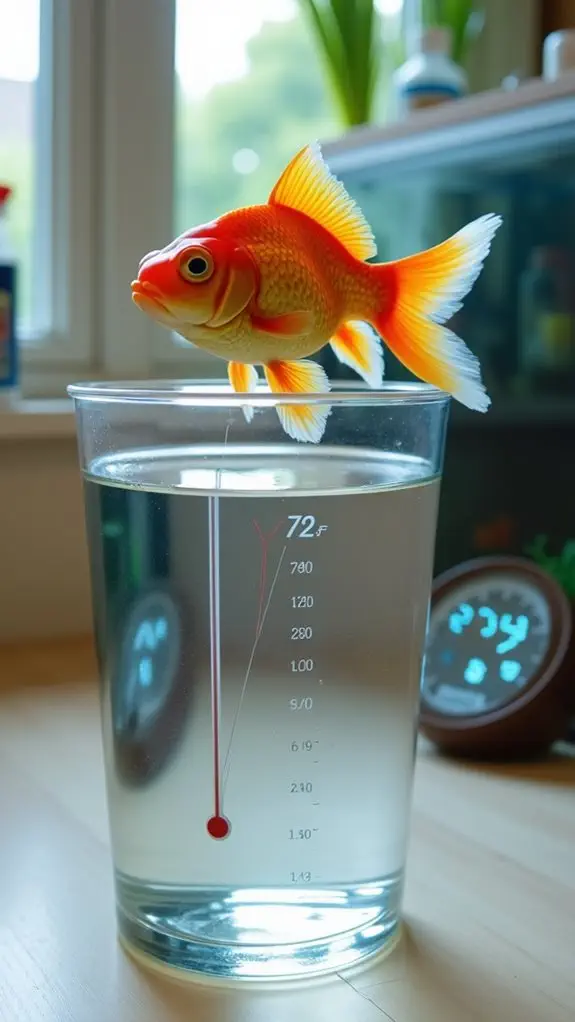
You'll need to get your fish out of that bucket within a week, even with perfect conditions, as oxygen levels can drop dangerously fast without proper aeration.
Watch for signs of distress like fish gasping at the surface or hanging near the water's top, which means it's time for fresh water or a move to a proper tank.
While you can maintain safe temperatures for about 24 hours in a well-insulated bucket, you're fighting an uphill battle against temperature swings that'll stress your finned friends. To help maintain healthier conditions, consider using beneficial bacteria supplements to stabilize the nitrogen cycle and keep your fish thriving.
Maximum Safe Holding Period
When keeping fish in a bucket, timing is critical for their survival. You'll want to monitor fish behavior closely, as your finned friends can only safely stay in a bucket for about 12 hours without special equipment.
For bucket safety, you can extend this time to around three days if you're using proper filtration, heating, and aeration systems.
Here's what you should watch for to keep your fish safe and comfortable:
- Signs of stress like rapid breathing or unusual swimming patterns that tell you it's time to return them to their tank.
- Changes in water clarity or smell that indicate declining water quality.
- Decreased activity levels that might mean oxygen levels are getting low.
- Crowding at the water surface, which signals your fish are struggling to breathe.
Signs of Oxygen Depletion
Understanding oxygen depletion signs can help you prevent fish fatalities during bucket storage. Your fish will send clear distress signals when oxygen levels drop, and it's essential to recognize these warning signs before it's too late.
Watch your fish's behavior closely while they're in the bucket. If you notice them swimming sluggishly or gathering near the surface gasping for air, that's your cue that oxygen levels are getting dangerously low.
They might also show rapid gill movements (like a person breathing heavily after running) or completely lose interest in food. Think of it as your fish's way of saying, "Hey, I can't breathe in here!"
You'll need to act quickly if you spot these signs. The simplest solution is to perform a partial water change with fresh, oxygenated water or add an air stone to the bucket.
If you've got multiple fish in one bucket, consider separating them to reduce oxygen demand. Remember, just like you wouldn't want to be crammed in a small space with limited air, your fish need adequate oxygen to stay healthy during their temporary bucket stay.
Temperature Control Timeline
A proper timeline for bucket storage can mean the difference between keeping your fish safe and putting them at risk. When you're dealing with temperature fluctuation effects, you'll need to be especially mindful of how long your fish stay in that temporary home.
Without a heater, your bucket's temperature can change quickly, making it unsafe for your finned friends after just 12 hours.
While bucket storage strategies can help you keep fish temporarily safe, here's what you need to know about timing:
- 12 hours – Your ideal maximum time without a heater (think quick tank cleanings or emergency situations)
- 24-48 hours – Maximum time for larger fish like angelfish or discus, even with proper setup
- 1 week – Possible duration for smaller fish with proper air supply and regular water changes
- 1 month – Absolute maximum in emergency situations, but you'll need careful monitoring
Signs of Fish Stress
Recognizing signs of fish stress is essential before temporarily moving them to a bucket or any new environment. Your fish can't tell you when they're feeling anxious, but they'll show you through their behavior. For effective stress relief, you'll need to watch for key warning signs that indicate your fish isn't feeling their best.
Keep an eye out for changes in your fish's appearance and swimming patterns. If you notice your fish's fins are clamped close to their body, or they're swimming erratically around the tank, that's a red flag. Your normally social swimmer might start hiding more frequently or lose interest in their favorite foods.
Color changes are another telltale sign – your vibrant friend might suddenly look pale or darker than usual.
Watch for any rapid breathing or gasping at the surface, which often signals distress. If your fish is showing these signs, it's vital to identify the cause before moving them.
Bucket Size Requirements
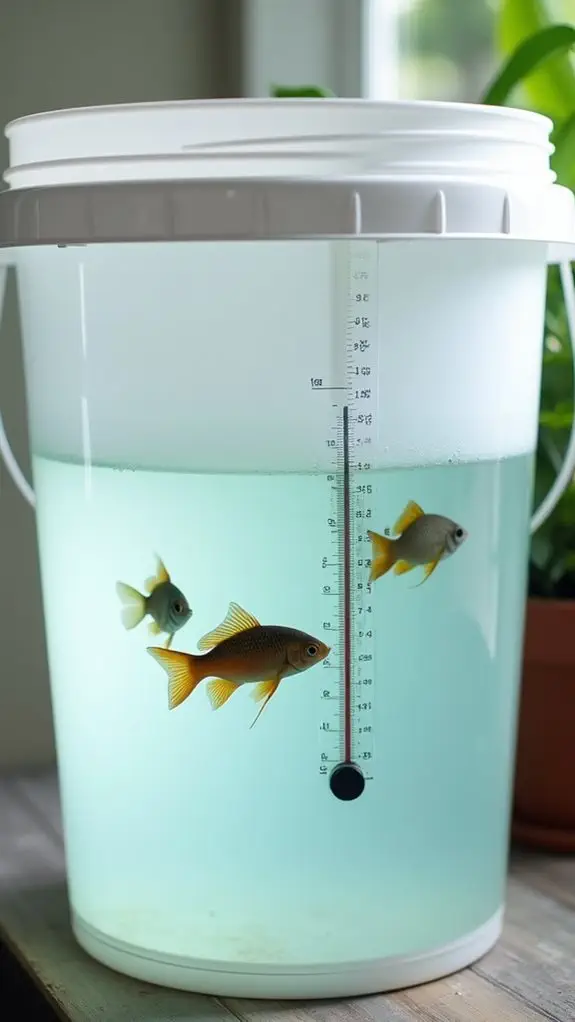
Selecting the right bucket size is essential for safely transporting your fish and performing water changes. You'll want to match your bucket volume to your tank size – for tanks up to 29 gallons, a 3-5 gallon bucket works perfectly, while larger aquariums over 30 gallons need at least a 5-gallon bucket.
Remember, your bucket material should be aquarium-safe to prevent any harmful chemicals from leaching into the water.
For successful water changes, here's what you need to take into account:
- Your fish's comfort and safety – a properly sized bucket reduces stress during temporary stays
- The weight you'll be lifting – don't strain yourself with an oversized bucket!
- The space you have available – make sure you can easily maneuver around
- Your tank's maintenance needs – larger tanks require bigger or multiple buckets
You'll want to use at least two identical buckets during water changes – one for removing old water and another for preparing fresh, dechlorinated water.
This way, you're ready to go as soon as you've removed the old water. Just remember to label your buckets "aquarium use only" to prevent any accidental contamination from household cleaning supplies.
Multiple Fish Management
Managing multiple fish in a bucket requires careful consideration of each species' needs and compatibility. When you're dealing with different fish types, you'll need to watch for signs of aggression and guarantee they can coexist peacefully in the temporary space.
Remember, what works in your aquarium mightn't work in a bucket's confined quarters. To maintain fish compatibility and reduce stress during tank cleaning, you'll want to group fish that get along well together.
If you've got peaceful community fish, they can usually share a bucket without issues. However, if you're keeping more aggressive species like African Cichlids, you might need separate containers to prevent territorial disputes.
Don't forget that schooling fish, such as rasboras and danios, should stay together to feel secure. Keep your fish in the temporary container for no more than 30 minutes to prevent oxygen depletion, and make sure the water temperature matches their tank.
It's best to use an airstone during this time to maintain proper oxygen levels. While your fish mightn't love their brief bucket vacation, following these guidelines will help keep them safe and stress-free during tank maintenance.
Equipment and Tools Needed

To successfully place your fish in a bucket, you'll need the right tools and equipment at your disposal.
Think of it as creating a cozy temporary home that'll keep your finned friends happy and healthy. Your primary focus should be on maintaining proper water conditions and reducing stress while your fish are in their temporary quarters.
- Must-Have Safety Items: A clean bucket with a secure lid (because nobody wants to play "find the jumping fish" behind the furniture!)
- Life-Supporting Equipment: An aerator or bubbler to keep oxygen levels up, ensuring your fish don't feel like they're gasping for air.
- Comfort Essentials: A reliable heater and thermometer to maintain that perfect temperature your fish are used to.
- Stress-Reduction Tools: Some floating plants or hiding spots to help your fish feel secure and protected.
Don't forget to add water conditioner to neutralize harmful chemicals, and keep your test kits handy to monitor water quality.
You'll want to position the bucket in a quiet spot away from direct sunlight and drafts.
Returning Fish to Tank
After your fish have spent time in their temporary bucket home, returning them safely to their main tank requires careful attention to detail. You'll want to watch for signs of normal fish behavior as they acclimate back to their familiar environment, guaranteeing tank stability throughout the process.
Before releasing your finned friends, float their temporary container in the main tank for about 15-20 minutes. This helps them adjust to any temperature differences and reduces stress. While you're waiting, check that your filtration system is running properly and that the water conditions are just right.
When it's time for the big move, gently release your fish into their freshly cleaned home. Don't just dump them in – use a net and transfer them carefully to avoid startling them.
Keep a close eye on your aquatic pals for the next few hours, as they might act a bit shy at first (wouldn't you, after a temporary relocation?). Make sure they're swimming normally and breathing well. If you notice any unusual behavior, like hiding or rapid gill movement, double-check your water parameters to verify everything's perfect for their comfort.
Frequently Asked Questions
What Happens if My Fish Gives Birth While in the Bucket?
If your fish gives birth in the bucket, you'll need to quickly separate the fry to prevent predation. The bucket stress can harm newborns, so transfer them carefully to a prepared tank using a cup.
Can I Use the Same Bucket for Different Species of Fish?
You can use the same bucket for different fish species if you maintain proper bucket sanitation between uses. Just guarantee the species are compatible and won't stress each other during temporary housing.
Should I Feed My Fish While They're in the Bucket?
You shouldn't feed your fish while they're in a bucket. Following proper feeding guidelines, it's best to skip meals during temporary transfers since fish can handle short fasts, and feeding increases fish stress levels.
Will My Fish Remember Their Territory When Returned to the Tank?
Yes, your fish's territorial instincts remain intact. They'll quickly recognize their previous territory through landmarks and spatial memory. Most fish behavior patterns, including territorial awareness, stay consistent even after short temporary relocations.
Can Medications Be Added to the Bucket Water During Tank Cleaning?
You can add medications to bucket water, but you'll need to carefully monitor the dosage and bucket water quality. It's essential to follow manufacturer's instructions and maintain proper concentration for the temporary holding period.
Final Thoughts
You're now equipped to safely house your fish in a bucket during tank maintenance. Remember to match water conditions, use a proper-sized container, and work efficiently to minimize stress on your aquatic friends. While it's not ideal for long-term storage, a clean bucket is an essential tool for temporary fish holding. With these guidelines in mind, you'll be a pro at keeping your fish comfortable during their brief "bucket vacation."

